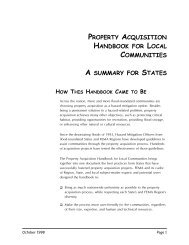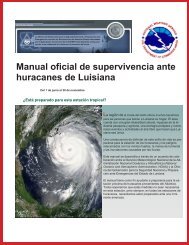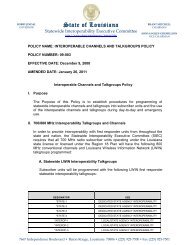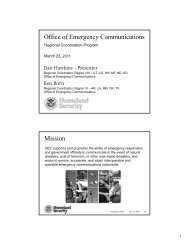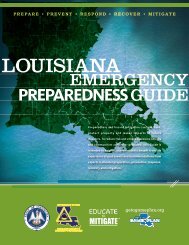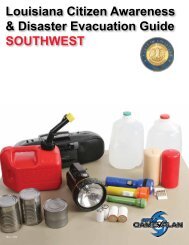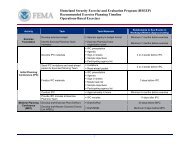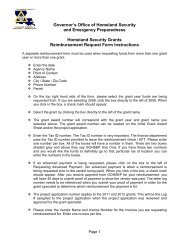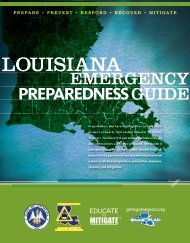Before the Federal Communications Commission Washington, D.C. ...
Before the Federal Communications Commission Washington, D.C. ...
Before the Federal Communications Commission Washington, D.C. ...
- No tags were found...
Create successful ePaper yourself
Turn your PDF publications into a flip-book with our unique Google optimized e-Paper software.
<strong>Federal</strong> <strong>Communications</strong> <strong>Commission</strong> FCC 02-6479. Several commenters request that we redefine four of <strong>the</strong> county subdivision codesidentified by <strong>the</strong> “P” portion of <strong>the</strong> six-digit “PSSCCC” location code. 187 The “P” portion of <strong>the</strong> locationcode is optional and allows <strong>the</strong> message originator to divide a county into nine sections to fur<strong>the</strong>rpinpoint <strong>the</strong> affected portion of <strong>the</strong> county. Currently, <strong>the</strong> county subdivisions are defined as follows: 0= all or an unspecified portion of a county; 1 = Northwest; 2 = North Central; 3 = Nor<strong>the</strong>ast; 4 = WestCentral; 5 = Central; 6 = East Central; 7 = Southwest; 8 = South Central; and 9 = Sou<strong>the</strong>ast. 188According to <strong>the</strong> commenters, this subdivision scheme does not work well within irregularly shapedcounties. The commenters <strong>the</strong>refore recommend that we drop <strong>the</strong> “central” from <strong>the</strong> North Central, WestCentral, East Central and South Central codes so that each of <strong>the</strong>se codes simply states its root compassdirection. We agree that this minor change will permit a more orderly and logical use of <strong>the</strong> countysubdivision scheme and we will revise <strong>the</strong> rules accordingly. Because we are simply revising <strong>the</strong>definitions of <strong>the</strong> codes, not <strong>the</strong> actual codes, this revision will not require any modification to existingequipment.80. Thunder Eagle complains that, as a matter of policy, NWS will not encode an alertmessage for more than six hours or reissue an alert message after <strong>the</strong> initial six-hour period, even though<strong>the</strong> message may actually have a valid time period of greater than six hours. 189 Thunder Eagle requeststhat we amend <strong>the</strong> Part 11 rules to specifically require ei<strong>the</strong>r (a) that <strong>the</strong> valid time period indicate <strong>the</strong>actual duration of <strong>the</strong> alert, or (b) that <strong>the</strong> issuing agency reissue <strong>the</strong> alert message at <strong>the</strong> end of every sixhourperiod for which a previously issued alert is still in effect. We will not amend <strong>the</strong> rules as requestedby Thunder Eagle. We think that this is a matter best left to <strong>the</strong> discretion of NWS and o<strong>the</strong>r agenciesthat issue EAS alerts.81. SBE requests that we specifically apply <strong>the</strong> EAS protocol and standards specified in <strong>the</strong>Part 11 rules to o<strong>the</strong>r radio services, such as amateur radio services (Part 97) and land mobile radioservices (Part 90), which have recently begun to transmit EAS and NWR-SAME messages. 190 Thisproposal is beyond <strong>the</strong> scope of <strong>the</strong> instant proceeding and will not be considered here.82. Finally, we are revising <strong>the</strong> Part 11 rules to make a few non-substantive and editorialamendments.IV. CONCLUSION83. In this Report and Order, we revise <strong>the</strong> technical and operational requirements for <strong>the</strong>EAS. In particular, we adopt new event codes and location codes to be used in transmitting EAS alerts to<strong>the</strong> public during state and local emergencies. Broadcast stations and cable systems will be permitted toupgrade <strong>the</strong>ir existing EAS equipment to include <strong>the</strong> new event and location codes on a voluntary basisuntil <strong>the</strong> equipment is replaced. Thus, <strong>the</strong> rules we are adopting in this proceeding will promote publicsafety by enhancing <strong>the</strong> performance and capabilities of EAS without imposing additional costs or187188WSAB/WA SECC Comments at 16-17; SBE Comments at 13-14; NWS Reply Comments at 2.See 47 C.F.R. § 11.31(c).189Thunder Eagle Comments at 2-3. For example, Thunder Eagle states that although Hurricane Watches andWarnings regularly last for 24 to 48 hour periods, NWS will not encode a Hurricane Watch or Warning alertmessage for more than six hours or reissue <strong>the</strong> alert after <strong>the</strong> initial six-hour period.190SBE Reply Comments at 12-13.32




